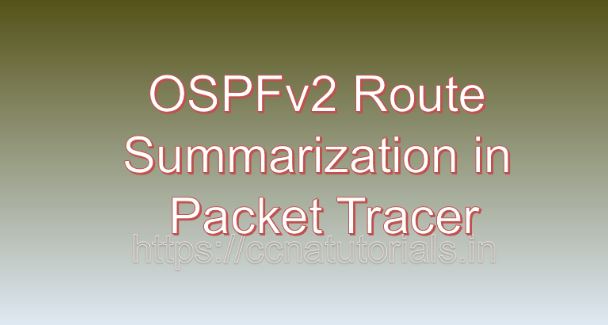Contents of this article
In this article, I describe the process of OSPFv2 Route Summarization in Packet Tracer. Open Shortest Path First version 2 (OSPFv2) is a widely-used interior gateway protocol (IGP) in computer networks. It’s renowned for its scalability, fast convergence, and robustness. One of the essential features of OSPFv2 is route summarization, which plays a crucial role in reducing routing table size, optimizing network performance, and simplifying routing information exchange. In this article, we’ll explore the concept of OSPFv2 route summarization and guide you through its configuration in Packet Tracer, a versatile network simulation tool.
Understanding OSPFv2 Route Summarization
Route summarization, also known as route aggregation or supernetting, involves consolidating multiple contiguous network addresses into a single summary route. By summarizing routes, OSPFv2 reduces the size of routing tables, minimizes routing protocol overhead, and enhances network efficiency. Summarization is particularly beneficial in large networks with hierarchical addressing structures.
Benefits of OSPFv2 Route Summarization
- Reduced Routing Table Size: By summarizing multiple routes into a single summary route, OSPFv2 reduces the size of routing tables, conserving memory and CPU resources on routers.
- Optimized Routing Protocol Exchange: Summarization minimizes the number of routing updates exchanged between OSPFv2 routers, leading to improved convergence times and reduced network traffic.
- Enhanced Network Scalability: Route summarization facilitates hierarchical network designs by aggregating subnets into larger address blocks, thereby enhancing network scalability and manageability.
Configuring OSPFv2 Route Summarization in Packet Tracer
Now, let’s walk through the process of configuring OSPFv2 route summarization in Packet Tracer. We’ll demonstrate this using a simple network topology consisting of multiple routers and subnets.
Step 1: Design Network Topology
Start by designing a network topology in Packet Tracer that includes OSPFv2-enabled routers and multiple subnets. Ensure that the subnets are organized hierarchically to facilitate route summarization.
Step 2: Enable OSPFv2 on Routers
On each router in the network, enable OSPFv2 routing using the following commands in global configuration mode:
Router(config) router ospf
Router(config-router) network areaReplace <process-id>, <network-address>, <wildcard-mask>, and <area-id> with appropriate values based on your network configuration.
Step 3: Configure Route Summarization
To configure route summarization in OSPFv2, use the area range command on the router’s OSPF configuration mode. This command specifies the range of IP addresses to be summarized and the summary address to be advertised.
Router(config-router) area rangeReplace <area-id>, <start-address>, and <end-address> with the appropriate values for your network.
Step 4: Verify Route Summarization
Once route summarization is configured, verify its effectiveness by examining the routing tables on OSPFv2 routers. Use the show ip route command to view the routing table and confirm that summarized routes are present.
Example Scenario: Corporate Network with OSPFv2 Route Summarization
As an example scenario, consider a corporate network comprising multiple branch offices connected via a central headquarters. By configuring OSPFv2 route summarization, you can aggregate branch office subnets into summary routes, simplifying routing information exchange and optimizing network performance.
Conclusion for OSPFv2 Route Summarization in Packet Tracer
OSPFv2 route summarization is a powerful technique for optimizing network performance, enhancing scalability, and simplifying routing in large-scale networks. By configuring route summarization in Packet Tracer, you can gain hands-on experience with this essential OSPFv2 feature and explore its benefits in a simulated environment. Whether you’re designing enterprise networks, ISP infrastructures, or data center environments, OSPFv2 route summarization offers significant advantages in terms of efficiency, scalability, and manageability.
With Packet Tracer, mastering OSPFv2 route summarization is both educational and practical, paving the way for effective network design and administration. I hope you found this article helpful related to OSPFv2 Route Summarization in Packet Tracer. You may drop a comment below or contact us for any queries of suggestions about the contents of this website.






